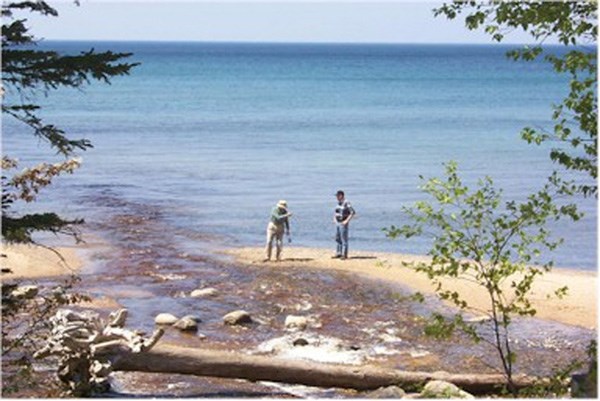Part of a series of articles titled Crystal Clear: A Call to Action.
Article
Crystal Clear: Algal Toxins in Surface Water at Great Lakes National Parks

NPS Photo
Background
Blue-green algae are microscopic organisms naturally present in lakes and streams that have the potential to form harmful algal blooms (HABs). While HABs can occur naturally, they are also caused by increased nutrient levels from fertilizers, waste water treatment plant discharge, and other sources. Consumption of large amounts of these toxins by animals or humans can result in muscle cramps, twitching, paralysis, cardiac or respiratory difficulty, nausea, vomiting, and liver failure. Simply coming into contact with algae blooms can also be harmful; nearly all bluegreen algae blooms can produce skin irritation, rashes, and gastrointestinal distress. One of the dominant blue-green algae in the Great Lakes region is Microcystis, which under certain conditions produces microcystin, a liver toxin and skin irritant. No data currently exist on how much microcystin and other algal toxins there are in surface waters at Isle Royale National Park, Pictured Rocks National Lakeshore, and Sleeping Bear Dunes National Lakeshore. These parks serve more than 1.6 million visitors annually, so it is important to track the presence of HABs and assess the status of algal toxins in the lakes at these parks to protect visitors from acute or chronic health effects. The main objective of this study is to determine concentrations of common algal toxins in surface water at Isle Royale, Pictured Rocks, and Sleeping Bear Dunes.Status
Water samples were collected three times in the summers of 2012 and 2013 at 16 inland lakes across the three parks, and at four Lake Michigan beach sites for Sleeping Bear Dunes. The samples were analyzed for common algal toxins by a USGS analytical laboratory in Lawrence, Kansas. This is a cooperative study between the USGS Michigan Water Science Center and the USGS Kansas Organic Geochemistry Research Laboratory, the NPS Great Lakes Inventory and Monitoring Network, and the individual park units. HABs were not observed in 2012 or 2013 at the lake and beach sites, but microcystins were detected at all six of Sleeping Bear Dunes’ inland lakes during at least one sampling round in 2012. Microcystins were also detected on one occasion in 2012 at one of the Lake Michigan beach sites. Microcystins were detected during all three sampling rounds at Trappers Lake at Pictured Rocks. However, for the 2012 field season the World Health Organization drinking water standard was only exceeded twice, once at Pictured Rocks and once at Sleeping Bear Dunes. Algal toxicity results for samples collected in 2013 are still pending. As a result of toxin detections in Trappers Lake, the Great Lakes Network has added it as a long-term index lake that will be routinely monitored under their inland lakes water quality monitoring protocol. The general pattern of a higher number of detections at Sleeping Bear Dunes compared with the other two parks is consistent with a 2008 State of Michigan algal toxicity study by the USGS Michigan Water Science Center, where some of the highest microcystin concentrations were found in lakes in the northwest corner of lower Michigan, near Sleeping Bear Dunes. Results of this study inform park managers and scientists about the occurrence and types of algal toxins that may be present and not previously known to occur at these parks. This baseline algal toxin information is critical for the protection of human, animal, and aquatic health. On a larger scale, little is known about the concentration of microcystin toxin in surface waters when algal blooms are not visible. This study will provide background information about the levels of these toxins in surface waters where HABs have not been observed. Baseline conditions are also important to monitor what effects climate variability may have on lakes in the future.Last updated: November 7, 2018
